Spiders
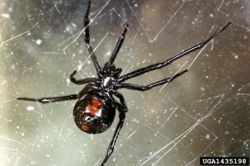
Female

Male
Habitat: The webs of these spiders are usually built in or beneath objects close to the ground such as under porches, under foundations of buildings, and in basements.
Brown Recluse or Fiddleback Spider
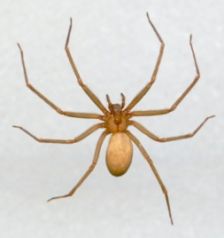 Description: The brown recluse spider is nicknamed the fiddleback or violin spider because of the distinctive dark violin-shaped marking on top of the cephlothorax front body section. Notice the neck of the violin points toward the rear. The brown recluse is unusual in having six eyes instead of the usual eight. The spiders re tan to dark brown and nearly 1/4 (dime) to 1/2 inch (quarter) in body size. The immature spiderlings resemble adults in structure but have somewhat lighter coloration.
Description: The brown recluse spider is nicknamed the fiddleback or violin spider because of the distinctive dark violin-shaped marking on top of the cephlothorax front body section. Notice the neck of the violin points toward the rear. The brown recluse is unusual in having six eyes instead of the usual eight. The spiders re tan to dark brown and nearly 1/4 (dime) to 1/2 inch (quarter) in body size. The immature spiderlings resemble adults in structure but have somewhat lighter coloration.
Habitat: Recluse spiders avoid areas where there is human activity, and prefer closets, guest rooms, basements, and attics. Outside, they like piles of rocks and leaves. They frequently inhabit shoe boxes, clothing and furniture. These spiders are most active at night and feed on silverfish, crickets, and other insects. Most people are bitten on the hands or feet when they are handling infested items.
Life Cycle: After mating, which may occur from February to October within its natural range, 40 to 50 eggs are deposited in off-white, round, 1/4 inch diameter silken cases. These are usually found in dark sheltered places on the spider's habitat. The summer months of May through August are optimal times for egg laying. From one to five egg sacs will be produced in a lifetime which normally averages from one to two years; however four to five years is not uncommon. After the eggs hatch, the young spiderlings undergo at least one molt (shedding of skin) within the egg sac. Subsequently, second instar spiderlings will emerge from the egg sac and undergo six to seven molts during the next seven to 12 months before reaching the adult stage. The presence of shed skins (exuviae) and subsequent attachment in and around residences may be indicative of infestations and enable accurate identification. Careful inspection of attics (including exposed rafters and ceiling joists), basements, closets, boxes and other household goods should reveal old and active infestation sites.
Bite: The bite of the brown recluse spider is usually painless. However, localized burning sensation often develops within the first hour and during the next 6-12 hours, a small pimple or blister forms. The surrounding tissue begins to darken and take a raised appearance. The venom of this spider can cause extensive tissue damage (necrotic reaction) and over the next 10-14 days, a sunken, open, ulcerated sore up to several centimeters in diameter. It normally takes 6-8 weeks for a brown recluse spider bite to heal. A large sunken scar may persist that requires surgery to repair. Not every brown recluse bite results in ulcer formation. In rare cases systemic complications such as liver or kidney damage result. See your physician or emergency room as soon as you suspect a brown recluse spider bite. Capture the spider for later identification (crush the specimen, if necessary, but do so as gently as possible). While the brown recluse's bite is dangerous, people rarely die from it.
Jumping Spider
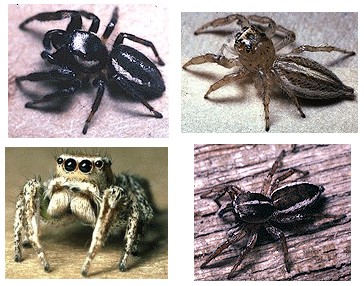 Description: These spiders are small to medium in size, with stout bodies and short legs. The group has a distinctive eye pattern, composed of 3 or 4 pairs, with the largest pair in the center. The body is rather hairy and if often brightly colored or iridescent. Jumping spiders are not venomous, though as with all spiders, bites may cause reactions in certain individuals.
Description: These spiders are small to medium in size, with stout bodies and short legs. The group has a distinctive eye pattern, composed of 3 or 4 pairs, with the largest pair in the center. The body is rather hairy and if often brightly colored or iridescent. Jumping spiders are not venomous, though as with all spiders, bites may cause reactions in certain individuals.
Habitat: Jumping spiders forage for their prey in the daytime and may be seen on windows, walls, or other areas where insect prey may be drawn to. They approach a prey slowly and, when close, make a sudden leap upon it. Before jumping they attach a silken thread or safety line which is used to climb back if they miss their target.
Tarantula
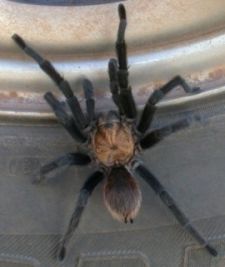 Description: Body length of 2 inches, leg span about 6 inches. Brown and black in color, stout-bodied, and covered with hollow, needle-like, barbed hairs, especially on the abdomen.
Description: Body length of 2 inches, leg span about 6 inches. Brown and black in color, stout-bodied, and covered with hollow, needle-like, barbed hairs, especially on the abdomen.
Habitat: Females are mostly nocturnal, hiding during the day in natural cavities in the ground, abandoned rodent tunnels, or burrows. Males wander in search of females and are more likely to be seen during the day. They may be active from any time from June to October but are most commonly seen in June and September. Females may live for 15-20 years.
Symptoms: Tarantulas will feed on any live animal they can catch and overpower, including large insects such as crickets, grasshoppers, and beetles. The bite of our tarantula is considered no more harmful than a bee sting. Some people may develop hypersensitivity reactions to their body hairs.
Wolf Spider
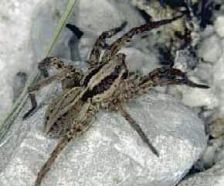 Description: Wolf spiders range from about 1/2 inch to 2 inches in length, hairy, and are typically brown to gray in color with various markings or lines. Wolf spider mothers carry their large egg sacs around with them. When the young spiderlings hatch they climb onto their mother's back and ride around until partially grown. Wolf spiders are not poisonous, though as with all spiders, bites may cause reactions in certain individuals.
Description: Wolf spiders range from about 1/2 inch to 2 inches in length, hairy, and are typically brown to gray in color with various markings or lines. Wolf spider mothers carry their large egg sacs around with them. When the young spiderlings hatch they climb onto their mother's back and ride around until partially grown. Wolf spiders are not poisonous, though as with all spiders, bites may cause reactions in certain individuals.
Habitat: Common household pest in the fall when they are looking for a warm place to overwinter. They are commonly found around doors, windows, house plants, basements, garages, and in almost all terrestrial habitats. They do not spin a web but roam at night to hunt for food. Wolf spiders are often confused with the brown recluse, but they lack the unmistakable violin-shaped marking behind the head. The wolf spider is shy and seeks to run away when disturbed.